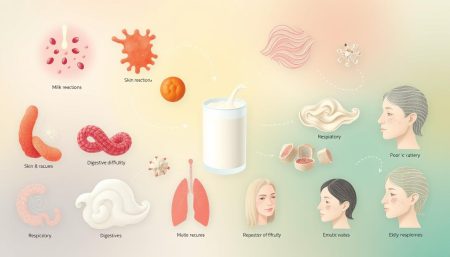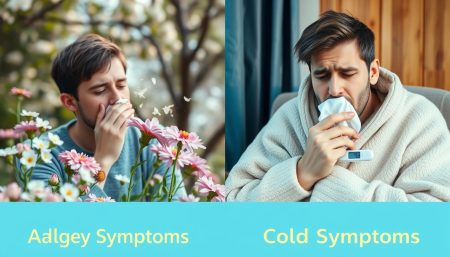Dust mites are tiny but can cause big problems in our homes. They lead to symptoms of dust mite allergy that can really disrupt our lives. Knowing the signs is key to staying healthy and enjoying our daily routines.
People with dust mite allergies often face more than just physical symptoms. These allergies can mess with sleep, work, and overall happiness. Hearing their stories helps us understand and empathize with their struggles.
- Early identification of dust mites allergy effects can significantly improve management strategies.
- Familiarizing oneself with the symptoms of dust mite allergy is crucial for those who suffer from recurrent respiratory or skin issues.
- Recognizing dust mites allergy is not just about physical health; it’s also about maintaining emotional wellness.
- Personal stories highlight the ubiquity of dust mite allergies and the importance of awareness and communal support.
- Being proactive in addressing dust mite allergies can lead to a better quality of life and reduce the emotional toll they may take.
Understanding Dust Mite Allergies: The Basics
When we talk about what is dust mite allergy, it’s key to know it’s an immune reaction to tiny bugs in dust. These bugs live in warm, humid places and eat dead skin cells. They love bedding, furniture, and carpets.
Dust mites are too small to see but they can really affect your health, especially if you’re allergic. The problem isn’t the mites themselves but their waste. This waste has proteins that many people are allergic to. This allergy can cause different dust mites allergy signs for each person.
Dust mite allergy is very common, making it one of the top allergies around the world. It’s important to know how they live and how allergies work to manage this issue well.
- Know your enemy: Dust mites are about 0.2–0.3 millimeters long, so you can’t see them without a magnifier.
- Environmental sustainability: They like temperatures between 68 to 77 degrees Fahrenheit and humidity of 70 to 80 percent.
- Primary culprits: The proteins in dust mite feces are strong allergens. When you breathe them in or touch your skin with them, you can get allergic reactions.
To really get what is dust mite allergy, knowing its signs is helpful. Common dust mites allergy signs are sneezing, runny nose, itchy eyes, and in serious cases, asthma attacks.
| Common Locations | Health Impact | Preventive Measures |
|---|---|---|
| Beddings, carpets, soft furnishings | Allergic rhinitis, asthma exacerbation | Use allergen-proof bed covers, maintain low humidity |
| Stuffed toys, clutter | Eczema, respiratory distress | Regular washing, decluttering living spaces |
Learning about these tiny bugs and their big health impact helps people take steps to avoid them. Knowing and teaching others about this common allergen is the first step to fighting it.
Identifying Dust Mites Allergy Symptoms
Many people struggle with dust mite allergies. They need to know the signs. These signs can affect breathing, skin, and eyes, making daily life hard.
Respiratory Reactions
Respiratory symptoms of dust mite allergies are often mistaken for colds. They include sneezing, coughing, and wheezing, especially at night. A tight chest is a sign of asthma, which dust mites can make worse.
It’s important to watch how long and how bad these symptoms are.
Skin Irritations
Skin reactions are clear signs of dust mite allergy. They can cause dry, itchy skin that gets worse if scratched. Rashes often appear in skin folds, making everyday tasks hard.
Ocular Symptoms
Eye problems are common but often ignored signs of dust mite allergy. They include red, itchy, and watery eyes that look like pink eye. These can lead to conjunctivitis if not treated.
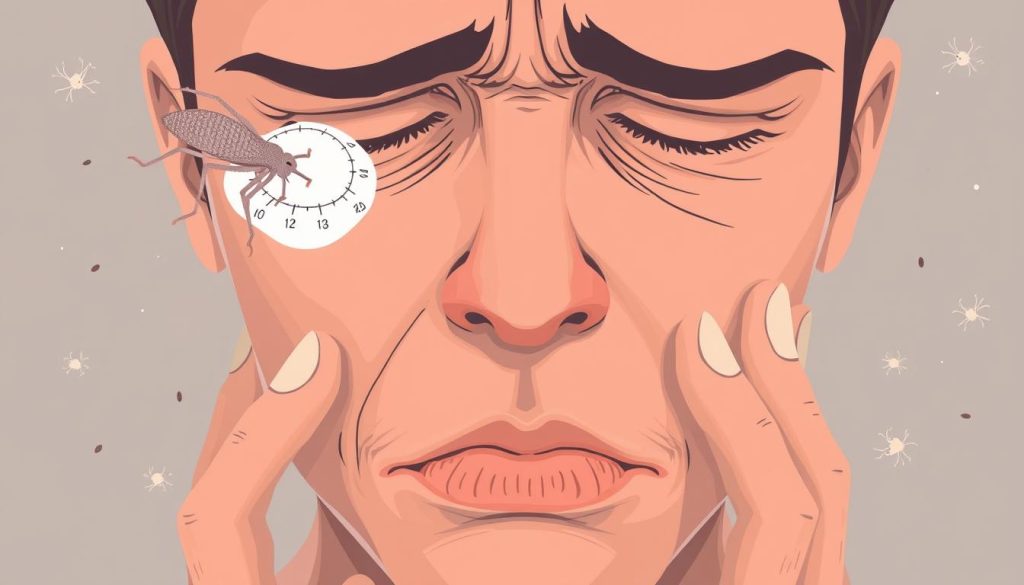
Spotting these symptoms is key to managing dust mite allergy. Knowing the type of reaction helps find the right treatment. This can ease the discomfort caused by dust mites.
What Causes Allergic Reactions to Dust Mites?
The relationship between humans and dust mites is often unseen but very important. These tiny creatures play a big role in dust mite allergy triggers. Understanding what causes allergic reactions to dust mites reveals a complex mix of allergens and the human immune system.
Dust mites live in warm, humid places and eat human skin flakes. It’s not the mites themselves but their waste and body parts that are the main allergens. When these allergens meet the respiratory system or skin, they can start an immune response in some people. The main allergens are Der p 1 and Der p 2, which can break down the skin and mucous membranes, causing allergic reactions.
This strong immune reaction is what leads to symptoms like sneezing, itching, and wheezing. Here’s how exposure to these allergens causes reactions:
- Inhalation: Dust mites allergy causes can start when you breathe in dust with mite waste and body parts, leading to breathing problems.
- Contact: Touching dust mites can cause skin reactions, especially in people with eczema or other skin issues.
- Adaptation: Long-term exposure can make the immune response worse, leading to more severe allergy symptoms or asthma.
Knowing these triggers helps manage and reduce allergies. Here’s a quick summary of the most common dust mite allergy triggers:
| Allergen Source | Common Reaction | Potential Long-Term Effect |
|---|---|---|
| Mite Feces | Nasal congestion, cough | Chronic rhinitis |
| Mite Body Fragments | Skin rashes, eczema | Exacerbated dermatological conditions |
| Enzymatic proteins | Eyelid swelling, wheezing | Asthma development |
These details show how important it is to know dust mites allergy causes and take steps to lessen their impact on people with allergies.
Common Misconceptions About Dust Mites Symptoms
When we talk about dust mite allergies, it’s key to know what’s true and what’s not. This helps us manage the condition better. We’ll clear up common myths and explain what dust mite symptoms really mean.
Myth vs. Fact: Skin Reactions
Many think any skin irritation means a dust mite allergy. But, not all irritations come from dust mites. Some could be eczema or other skin problems. Let’s look at how to tell the difference:
| Symptom | Dust Mites Allergy | Other Skin Conditions |
|---|---|---|
| Itchiness | Common around the wrists, arms, and waist | Often more generalized |
| Redness | Frequently accompanies itchiness | May be present with or without itchiness |
| Appearance | Small, raised bumps | Varies widely (e.g., scaling, flaking) |
Myth vs. Fact: Seasonal Allergies
Some people mix up dust mite allergy symptoms with seasonal allergies. It’s important to know the difference, especially when pollen counts are high.
- Timing: Dust mite allergies can happen all year and aren’t affected by seasons.
- Symptoms: Both can cause sneezing and a runny nose. But, dust mite allergies can keep symptoms going, even when pollen counts are low.
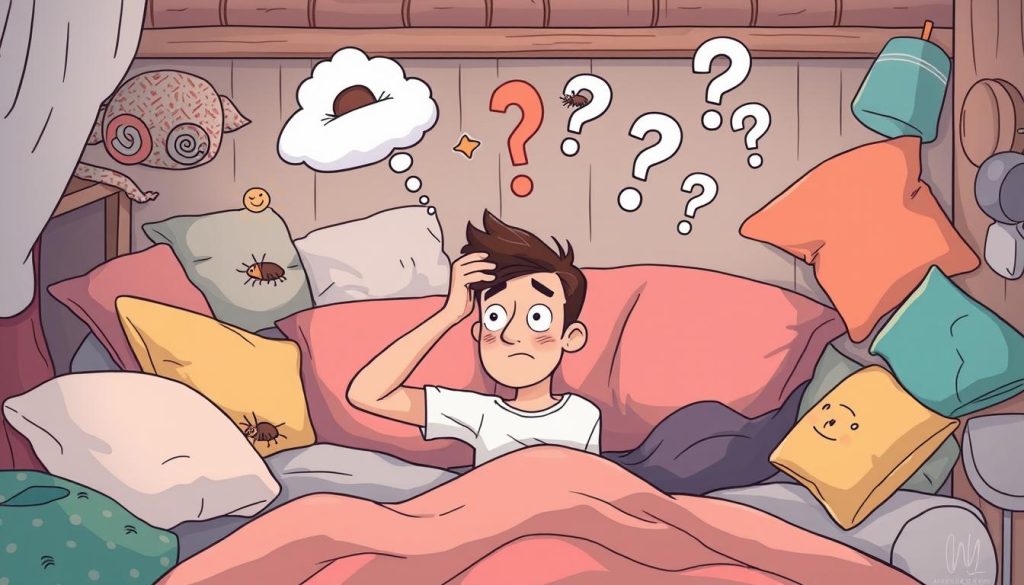
Knowing these differences is the first step to better managing dust mite allergies.
Recognizing Dust Mites Allergy Signs in Children
Understanding and addressing allergies in children is crucial for their health. House dust mites are a common allergen that can cause reactions in kids. It’s important to know the signs of dust mites allergy in children to help them feel better.
Pediatric Symptoms of Dust Mite Allergy
Kids with dust mite allergies may show different symptoms than adults. Look out for:
- Frequent sneezing and nasal congestion
- Red, itchy eyes
- Eczema or frequent skin rashes
- Respiratory issues such as coughing or wheezing, especially at night
These symptoms can really impact their daily life. It’s important to catch them early and get help.
When to Seek Professional Advice for Your Child
If your child often shows signs of dust mite allergy, see a pediatrician. They can confirm the diagnosis and suggest treatments. You should seek help if:
- Symptoms last more than a week
- Over-the-counter meds don’t help
- Allergies make it hard to sleep or do daily activities
- Symptoms get worse and make breathing hard
A doctor can help manage the allergy. They can suggest ways to reduce allergens and treatments. This can greatly improve your child’s life. Getting help early can prevent more serious problems.
How to Differentiate Between Dust Mites Allergy and Colds
It can be hard to tell if symptoms come from dust mites allergy or a cold. Knowing the tell-tale signs of dust mite allergy is key to taking care of your health. This part will help you tell these conditions apart by looking at when symptoms start, how long they last, and what they are like.
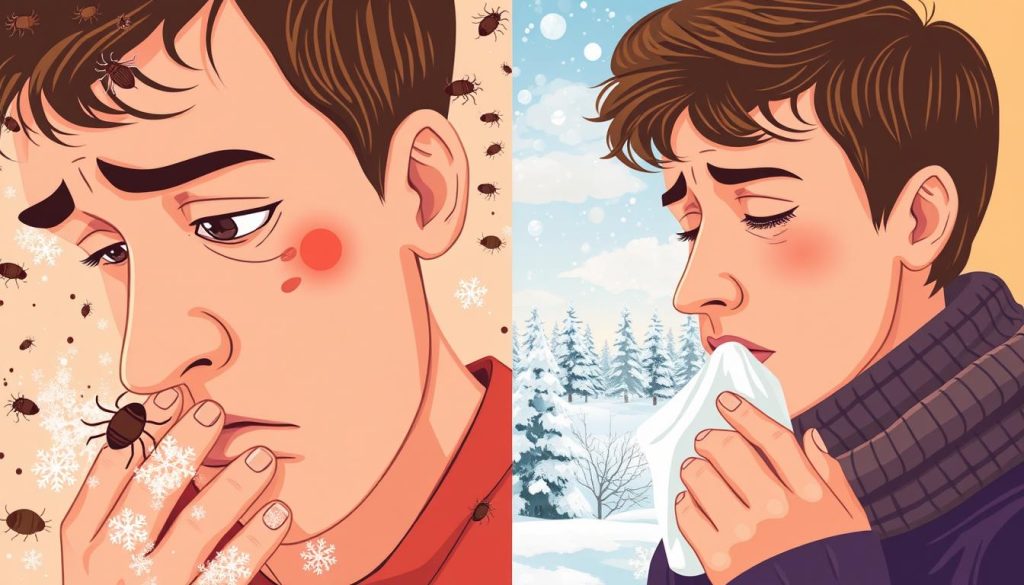
Symptoms: Dust mite allergies often cause long-lasting symptoms like sneezing, a runny or itchy nose, and itchy eyes. Colds start with a sore throat, then you might sneeze, have a runny nose, and cough.
| Symptom | Dust Mite Allergy | Cold |
|---|---|---|
| Nasal Congestion | Frequent, often severe | Moderate, typically resolves in 5-7 days |
| Skin Reaction | Common (eczema, itching) | Rare |
| Duration | Year-round symptoms, may worsen with dust exposure | Lasts usually 7-10 days |
| Eyes | Itchy and watery | Seldom affected |
Duration and Trigger Exposure: A big clue in telling dust mites allergy vs cold symptoms apart is how long symptoms last and how often you’re exposed to triggers. Allergy symptoms keep coming back as long as you’re around allergens, all year. Colds usually go away in a week and happen more in the cold months.
- Immediate reaction: Allergic reactions to dust mites happen right after you’re exposed to dust.
- Chronic presence: Dust allergy symptoms can keep coming back or happen often if you keep being exposed.
Knowing these differences helps people make better choices about when to see a doctor and how to handle their symptoms.
Managing Dust Mites Allergy: Prevention Tips
Effective dust mites allergy management starts with taking steps to prevent dust mites allergy at home. Understanding and using targeted cleaning strategies can greatly reduce dust mite exposure. This makes your living space healthier. Here are some key steps to follow:
Reducing Dust Mites at Home
- Avoid heavy drapes and opt for washable curtains or blinds.
- Choose hardwood floors over carpets, particularly in bedrooms.
- Maintain humidity below 50% to deter dust mites growth.
- Encase mattresses and pillows in dust mite-proof covers.
- Regularly wash bedding in hot water (at least 130°F) to kill dust mites.
- Use a vacuum with a HEPA filter regularly to minimize dust accumulation.
Essential Cleaning Strategies
Keeping a regular cleaning routine is key to controlling allergens. Here are some tips to help you keep your home dust mite-free:
- Vacuum soft furnishings and floors weekly using a HEPA filter equipped vacuum cleaner.
- Wet-dust surfaces frequently to avoid circulating allergens in the air.
- Launder throw rugs and blankets often, and dry in a hot dryer to kill dust mites.
- Consider using air purifiers with HEPA filters in bedrooms to further reduce airborne allergens.
- Avoid clutter where dust could accumulate. Declutter surfaces and maintain a minimalistic decor.
By following these practices, you can manage and prevent dust mites allergy. This improves indoor air quality and may reduce allergy symptoms.
Dust Mite Allergy Diagnosis: Testing and Identification
Knowing how to diagnose dust mite allergy is key to managing it well. This allergy needs special tests to find out if you’re allergic to dust mites.
A doctor will start by talking about your health history and symptoms. If they think you might have a dust mite allergy, they might use two tests: skin prick tests and specific IgE blood tests.
- Skin Prick Tests: This test puts a small amount of allergen on your skin. It’s usually on your forearm or back. Then, a tiny needle pricks the skin through the allergen.
- Specific IgE Blood Tests: This test checks your blood for IgE antibodies to specific allergens, like dust mites.

Understanding the test results helps figure out how to manage your allergy. If the results are positive, you’ll get a treatment plan. This plan might include avoiding certain things, taking medicine, and possibly allergy shots.
| Test Type | Description | Common Use |
|---|---|---|
| Skin Prick Test | Introduces allergens under the skin surface | Quick assessment of allergic reactions |
| Specific IgE Blood Test | Measures IgE antibodies in blood | Confirms sensitivity levels to specific allergens |
Getting a correct diagnosis of dust mite allergy is vital. It helps manage the allergy better and improves your life. Doctors are key in understanding test results and helping you manage your allergy.
Treatment Options for Dust Mite Allergy
Looking into dust mite allergy treatment is key to better living. We’ll cover treatments from simple over-the-counter options to stronger prescription drugs and allergy shots.
Over-the-Counter Medications
For those with mild allergies, over-the-counter meds are a good start. Antihistamines and decongestants help with congestion. Nasal sprays can also reduce swelling and make breathing easier.
Prescription Medications
For serious cases, doctors might suggest stronger meds. These include stronger antihistamines or corticosteroids for better symptom relief. Leukotriene receptor antagonists block immune system chemicals that cause allergies.
Allergy Immunotherapy
Allergy shots are a long-term fix for severe allergies. They work by slowly increasing the amount of allergens you’re exposed to. This helps your body get used to them over time. It’s a good choice for those who don’t get better with usual treatments.
The Role of Dust Mites in Asthma and Allergic Reactions
Dust mites are tiny creatures that live in household dust. They are a common cause of dust mite allergy and asthma. These pests can really affect people who are allergic to them, making it key to know how to handle dust mites allergy complications. It’s important to understand how dust mites and breathing problems are connected to keep homes healthy.
Being around dust mites can make asthma symptoms worse. This includes wheezing, coughing, tight chest, and feeling short of breath. It’s vital to manage these symptoms well to prevent severe asthma attacks. Keeping your home clean and dry can help control dust mite numbers, which helps asthma patients.

- Use allergen-proof bed covers to reduce exposure while sleeping.
- Wash bedding in hot water weekly to kill dust mites.
- Maintain low indoor humidity levels, ideally between 30% and 50%.
- Use high-efficiency particulate air (HEPA) filters to trap dust mites and other allergens.
For those with dust mite allergy and asthma, getting professional allergy tests can help. These tests can guide how to manage the condition better. Doctors might suggest antihistamines, corticosteroids, or asthma inhalers. It’s important to talk to a doctor to find the best treatment for you.
Knowing how to manage your environment can help prevent dust mite allergy problems. It can also help those with both allergies and asthma. With the right steps, you can control these conditions better and improve your life quality.
The Impact of Dust Mites Allergy on Daily Life
Living with dust mites allergy can change your life a lot. It affects how you feel and your health. Knowing how it impacts life is key to managing symptoms. This part talks about how it can mess with sleep and daily life.
Quality of Sleep
For many, nights are hard because symptoms don’t go away. Dust mite allergies can cause sneezing, stuffy nose, and itchy eyes. These problems make it hard to sleep well.
This lack of sleep can make you feel tired and grumpy. It makes everyday tasks harder to do.
Overall Wellness and Productivity
Poor sleep can hurt your health and how well you do things. People with dust mite allergies might feel stressed and get sick more often. This can make it tough to focus and do well at work or school.
A balanced approach to managing these symptoms is key. Keeping your place clean and using special bedding can help. Medical treatments can also help control the allergy. This can make life better for those affected.
| Symptom | Impact on Sleep | Impact on Daytime Function |
|---|---|---|
| Nasal Congestion | Frequent awakenings | Reduced mental clarity |
| Itchy Eyes | Difficulty falling asleep | Lowered visual focus |
| Sneezing | Interrupted sleep cycle | Increased irritability |
Dealing with dust mites allergy needs a big plan. It should include changing your environment and getting medical help. By doing both, you can improve your sleep and do better in daily life.
Conclusion
We’ve explored the world of dust mite allergies and found a path to empowerment. Knowing the signs of dust mite allergies is key. It helps us tackle these allergies effectively.
It’s important to tell the difference between dust mite allergy symptoms and colds or other allergies. This step is crucial for the right treatment and management.
Beating dust mite allergies is a team effort. It includes controlling the environment, using medicines, and sometimes allergy shots. Understanding and managing allergies can greatly improve our lives.
To those fighting allergies, know you’re not alone. Your struggles are real, and your efforts to find relief are worth it. Keep learning and using the advice given to make your space healthier.
Don’t give up on a better life despite allergies. You have the tools and support to help you succeed.
FAQ
Q: What are common symptoms of dust mite allergy?
A: Symptoms include sneezing and nasal congestion. You might also have itchy or watery eyes. Coughing, wheezing, and shortness of breath are common too. Eczema or other skin irritations can also occur.
Q: How can dust mite allergies affect daily life?
A: Dust mite allergies can make daily life tough. They cause discomfort and disrupt sleep. This can lower your overall wellness and affect your focus and productivity.
Q: What are dust mites and why are they a common allergen?
A: Dust mites are tiny creatures in household dust. They live in warm, humid places and eat human skin flakes. Many people react to their waste and decaying bodies, making them a common allergen.
Q: What triggers allergic reactions to dust mites?
A: Allergic reactions happen when you breathe in or touch dust mite particles. This triggers your immune system, leading to symptoms.
Q: How can I recognize dust mite allergy symptoms in my child?
A: Look for signs like nasal congestion and sneezing in kids. They might also have a runny nose, itchy nose or throat, and coughing. Wheezing, difficulty breathing, or skin rashes are also signs. Poor sleep quality can be a clue too.
Q: What are some effective ways to manage dust mite allergies at home?
A: Lowering indoor humidity helps. Use allergen-proof covers on mattresses and pillows. Wash bedding in hot water weekly. Vacuum and dust often. Remove or reduce dusty items to manage allergies.
Q: Are skin reactions to dust mites always related to allergy?
A: No, not always. Skin reactions like eczema can be from dust mite allergy or other causes. Getting a proper diagnosis is key to find the cause.
Q: How can I differentiate between a dust mite allergy and a common cold?
A: Dust mite allergies and colds share symptoms. But allergies last longer and are more repetitive. Allergies don’t usually cause fever or body aches, unlike colds.
Q: What treatment options are available for dust mite allergy?
A: Treatments include over-the-counter antihistamines and decongestants. Nasal corticosteroids and prescription medications are also options. Allergy shots or tablets are another choice.
Q: Can dust mite allergies lead to other complications?
A: Yes, they can make asthma worse and lead to respiratory issues. Long-term exposure can cause inflammation. This might lead to asthma in people who are prone to it.













